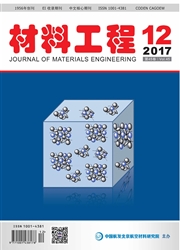

 中文摘要:
中文摘要:
采用紧凑拉伸(CT)试样对三种晶体取向[001],[011],[111]的镍基单晶合金DD3在950,850℃和760℃下的拉伸以及950℃时的蠕变和疲劳性能进行了实验研究。应用光学显微镜(OM)和扫描电子显微镜(SEM)分别对单晶体裂纹扩展路径和断口表面进行了观察和分析。拉伸实验结果表明:单晶体裂纹扩展路径沿着特定的晶体学矢量方向扩展而在试样自由表明呈现Z字型外观,其扩展方向及形状取决于晶体取向。温度对试样的断裂形式影响较为显著,760℃时的断裂特征为剪切型脆性断裂,断裂平面为沿滑移面的光滑斜断口;950℃下试样断裂逐渐转变为微孔聚集型韧性断裂,断口由粗糙的剪切唇和纤维区构成。蠕变和疲劳实验结果表明:镍基单晶具有明显的蠕变和疲劳性能各向异性,蠕变寿命以[011],[111],[001]顺序依次减小,疲劳寿命以[111],[011],[001]顺序依次减小;蠕变及疲劳裂纹扩展路径均与加载方向垂直,断裂表面均为光滑的平断口。试样断口细观分析显示,蠕变试样断口由杯锥状韧窝组成,而疲劳试样断口则由疲劳裂纹组成。疲劳损伤比蠕变损伤更有利于裂纹的扩展。
 英文摘要:
英文摘要:
The fracture behaviour of compact tension (CT) specimens of nickel-based single crystal superalloys DD3 was studied at 950, 850, 760℃. The creep and fatigue property was investigated at 950℃. Three crystallographic orientations [001], [011] and [111] of the specimens were considered. The macro crack growth and micro characterization of the fracture surfaces were examined by the optical microscope (OM) and scan electron microscope (SEM). The tension experimental results show that the macro crack growth path takes place in specific vectors and appears to be in a zigzag manner. The temperature has much influence on fracture behaviour. At low temperature (760℃), the fracture mode is pure shear fracture and belongs to brittle mode. But at high temperature (950℃), fracture mode turns to be microvoid coalescence fracture and belongs to ductile mode. The creep and fatigue properties of CT specimens are-obviously anisotropic. Creep life decreases in the order of [011], [111], [,001] and fatigue life decreases in the order of [111], [011], [,001] under same test conditions. The creep and fatigue crack growth path is perpendicular to the loading axis. It is found by SEM that there are much cup-cone dimple on the creep fracture and typical fatigue striations on the fatigue fracture surface. The fracture damage can results in crack growth more easily than creep damage.
 同期刊论文项目
同期刊论文项目
 同项目期刊论文
同项目期刊论文
 期刊信息
期刊信息
